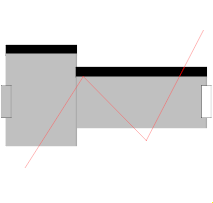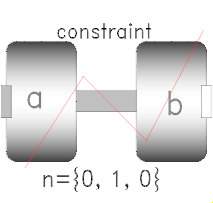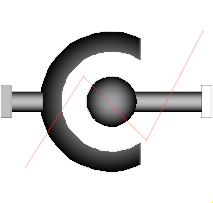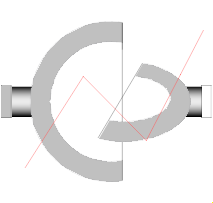 Package Modelica.Mechanics.MultiBody.Joints.Constraints
Package Modelica.Mechanics.MultiBody.Joints.ConstraintsComponents that define joints by constraints
 Package Modelica.Mechanics.MultiBody.Joints.Constraints
Package Modelica.Mechanics.MultiBody.Joints.Constraints
This package contains constraint components, that is, idealized, massless elements that constrain the motion between frames by means of kinematic constraints. The constraint elements are especially aimed to be used for multibody models which contain kinematic loops. Usually, kinematic loops are automatically handled. However, the performance might be improved by either solving certain kinds of loops analytically with the help of the components of subpackage Assemblies, or by providing numerically better loop constraint formulations with the help of the components of this subpackage.
Extends from Modelica.Icons.Package (Icon for standard packages).
| Name | Description |
|---|---|
Prismatic | Prismatic cut-joint and translational directions may be constrained or released |
Revolute | Revolute cut-joint and translational directions may be constrained or released |
Spherical | Spherical cut joint and translational directions may be constrained or released |
Universal | Universal cut-joint and translational directions may be constrained or released |
 Model Modelica.Mechanics.MultiBody.Joints.Constraints.Prismatic
Model Modelica.Mechanics.MultiBody.Joints.Constraints.Prismatic
This model does not use explicit variables e.g. state variables in order to describe the relative motion of frame_b with respect to frame_a, but defines kinematic constraints between the frame_a and frame_b. The forces and torques at both frames are then evaluated in such a way that the constraints are satisfied. Sometimes this type of formulation is also called an implicit joint in literature.
As a consequence of the formulation the relative kinematics between frame_a and frame_b cannot be initialized.
In particular in complex multibody systems with closed loops this may help to simplify the system of non-linear equations. Please compare the translation log using the classical joint formulation and the alternative formulation used here in order to check whether this fact applies to the particular system under consideration.
In systems without closed loops the use of this implicit joint does not make sense or may even be disadvantageous.
See the subpackage Examples.Constraints for testing the joint.
Extends from Modelica.Mechanics.MultiBody.Interfaces.PartialTwoFrames (Base model for components providing two frame connectors + outer world + assert to guarantee that the component is connected).
| Type | Name | Default | Description |
|---|---|---|---|
Boolean | x_locked | true | = true: constraint force in x-direction, resolved in frame_a |
Boolean | y_locked | true | = true: constraint force in y-direction, resolved in frame_a |
Boolean | z_locked | true | = true: constraint force in z-direction, resolved in frame_a |
Boolean | animation | true | = true, if animation shall be enabled (show sphere) |
Distance | sphereDiameter | 0.333333333333333 * world.defaultJointLength | Diameter of sphere representing the spherical joint |
| Type | Name | Default | Description |
|---|---|---|---|
Color | sphereColor[3] | Types.Defaults.JointColor | Color of sphere representing the spherical joint |
SpecularCoefficient | specularCoefficient | world.defaultSpecularCoefficient | Reflection of ambient light (= 0: light is completely absorbed) |
| Type | Name | Description |
|---|---|---|
Frame_a | frame_a | Coordinate system a fixed to the component with one cut-force and cut-torque |
Frame_b | frame_b | Coordinate system b fixed to the component with one cut-force and cut-torque |
 Model Modelica.Mechanics.MultiBody.Joints.Constraints.Revolute
Model Modelica.Mechanics.MultiBody.Joints.Constraints.Revolute
This model does not use explicit variables e.g. state variables in order to describe the relative motion of frame_b with respect to frame_a, but defines kinematic constraints between the frame_a and frame_b. The forces and torques at both frames are then evaluated in such a way that the constraints are satisfied. Sometimes this type of formulation is also called an implicit joint in literature.
As a consequence of the formulation the relative kinematics between frame_a and frame_b cannot be initialized.
In particular in complex multibody systems with closed loops this may help to simplify the system of non-linear equations. Please compare the translation log using the classical joint formulation and the alternative formulation used here in order to check whether this fact applies to the particular system under consideration.
In systems without closed loops the use of this implicit joint does not make sense or may even be disadvantageous.
See the subpackage Examples.Constraints for testing the joint.
Extends from Modelica.Mechanics.MultiBody.Interfaces.PartialTwoFrames (Base model for components providing two frame connectors + outer world + assert to guarantee that the component is connected).
| Type | Name | Default | Description |
|---|---|---|---|
Boolean | x_locked | true | = true: constraint force in x-direction, resolved in frame_a |
Boolean | y_locked | true | = true: constraint force in y-direction, resolved in frame_a |
Boolean | z_locked | true | = true: constraint force in z-direction, resolved in frame_a |
Boolean | animation | true | = true, if animation shall be enabled (show sphere) |
Axis | n[3] | {0, 1, 0} | Axis of rotation resolved in frame_a (= same as in frame_b) |
Distance | sphereDiameter | 0.333333333333333 * world.defaultJointLength | Diameter of sphere representing the spherical joint |
| Type | Name | Default | Description |
|---|---|---|---|
Color | sphereColor[3] | Types.Defaults.JointColor | Color of sphere representing the spherical joint |
SpecularCoefficient | specularCoefficient | world.defaultSpecularCoefficient | Reflection of ambient light (= 0: light is completely absorbed) |
| Type | Name | Description |
|---|---|---|
Frame_a | frame_a | Coordinate system a fixed to the component with one cut-force and cut-torque |
Frame_b | frame_b | Coordinate system b fixed to the component with one cut-force and cut-torque |
 Model Modelica.Mechanics.MultiBody.Joints.Constraints.Spherical
Model Modelica.Mechanics.MultiBody.Joints.Constraints.Spherical
This model does not use explicit variables e.g. state variables in order to describe the relative motion of frame_b with to respect to frame_a, but defines kinematic constraints between the frame_a and frame_b. The forces and torques at both frames are then evaluated in such a way that the constraints are satisfied. Sometimes this type of formulation is also called an implicit joint in literature.
As a consequence of the formulation the relative kinematics between frame_a and frame_b cannot be initialized.
In particular in complex multibody systems with closed loops this may help to simplify the system of non-linear equations. Please compare the translation log using the classical joint formulation and the alternative formulation used here in order to check whether this fact applies to the particular system under consideration.
In systems without closed loops the use of this implicit joint does not make sense or may even be disadvantageous.
See the subpackage Examples.Constraints for testing the joint.
Extends from Modelica.Mechanics.MultiBody.Interfaces.PartialTwoFrames (Base model for components providing two frame connectors + outer world + assert to guarantee that the component is connected).
| Type | Name | Default | Description |
|---|---|---|---|
Boolean | x_locked | true | = true: constraint force in x-direction, resolved in frame_a |
Boolean | y_locked | true | = true: constraint force in y-direction, resolved in frame_a |
Boolean | z_locked | true | = true: constraint force in z-direction, resolved in frame_a |
Boolean | animation | true | = true, if animation shall be enabled (show sphere) |
Distance | sphereDiameter | 0.333333333333333 * world.defaultJointLength | Diameter of sphere representing the spherical joint |
| Type | Name | Default | Description |
|---|---|---|---|
Color | sphereColor[3] | MBS.Types.Defaults.JointColor | Color of sphere representing the spherical joint |
SpecularCoefficient | specularCoefficient | world.defaultSpecularCoefficient | Reflection of ambient light (= 0: light is completely absorbed) |
| Type | Name | Description |
|---|---|---|
Frame_a | frame_a | Coordinate system a fixed to the component with one cut-force and cut-torque |
Frame_b | frame_b | Coordinate system b fixed to the component with one cut-force and cut-torque |
 Model Modelica.Mechanics.MultiBody.Joints.Constraints.Universal
Model Modelica.Mechanics.MultiBody.Joints.Constraints.Universal
This model does not use explicit variables e.g. state variables in order to describe the relative motion of frame_b with respect to frame_a, but defines kinematic constraints between the frame_a and frame_b. The forces and torques at both frames are then evaluated in such a way that the constraints are satisfied. Sometimes this type of formulation is also called an implicit joint in literature.
As a consequence of the formulation the relative kinematics between frame_a and frame_b cannot be initialized.
In particular in complex multibody systems with closed loops this may help to simplify the system of non-linear equations. Please compare the translation log using the classical joint formulation and the alternative formulation used here in order to check whether this fact applies to the particular system under consideration.
In systems without closed loops the use of this implicit joint does not make sense or may even be disadvantageous.
See the subpackage Examples.Constraints for testing the joint.
Extends from Modelica.Mechanics.MultiBody.Interfaces.PartialTwoFrames (Base model for components providing two frame connectors + outer world + assert to guarantee that the component is connected).
| Type | Name | Default | Description |
|---|---|---|---|
Axis | n_a[3] | {1, 0, 0} | Axis of revolute joint 1 resolved in frame_a |
Axis | n_b[3] | {0, 1, 0} | Axis of revolute joint 2 resolved in frame_b |
Boolean | x_locked | true | = true: constraint force in x-direction, resolved in frame_a |
Boolean | y_locked | true | = true: constraint force in y-direction, resolved in frame_a |
Boolean | z_locked | true | = true: constraint force in z-direction, resolved in frame_a |
Boolean | animation | true | = true, if animation shall be enabled (show sphere) |
Distance | sphereDiameter | 0.333333333333333 * world.defaultJointLength | Diameter of sphere representing the spherical joint |
| Type | Name | Default | Description |
|---|---|---|---|
Color | sphereColor[3] | MBS.Types.Defaults.JointColor | Color of sphere representing the spherical joint |
SpecularCoefficient | specularCoefficient | world.defaultSpecularCoefficient | Reflection of ambient light (= 0: light is completely absorbed) |
| Type | Name | Description |
|---|---|---|
Frame_a | frame_a | Coordinate system a fixed to the component with one cut-force and cut-torque |
Frame_b | frame_b | Coordinate system b fixed to the component with one cut-force and cut-torque |